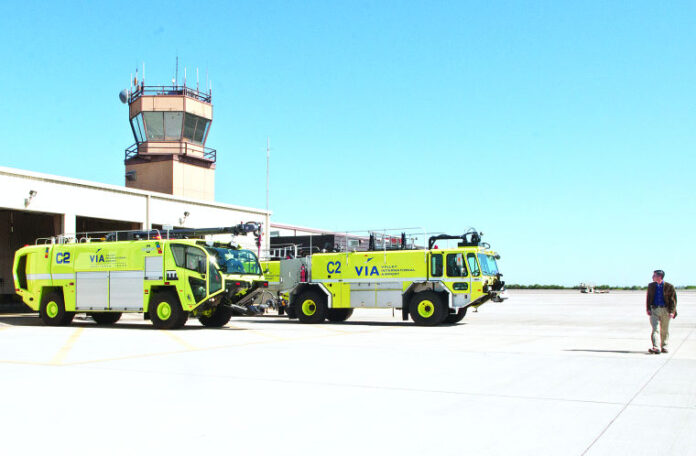HARLINGEN — A new $3.8 million firehouse at Valley International Airport is set to open for business and training.
The nearly 18-month construction phase for the state-of-the-art Airport Rescue and Firefighting Facility, called ARFF, is over. If the airport passes a Federal Aviation Administration inspection today, it will be move-in time for the airport fire and rescue team.
“It’s like going from a VW Volkswagen Beetle to a new Cadillac,” Marv Esterly, director of aviation at VIA, said last week. “It has all the bells and whistles that are needed to make sure they have what they need to keep us all safe.”
The new ARFF facility at the airport is just the latest upgrade to come online within the past year or two.
The airport has finished reworking one of its main runways to make it in effect longer, two new firefighting vehicles were purchased, a new HVAC system was installed and new LED lighting was installed on runways and inside the airport itself.
The ARFF facility will accommodate nine full-time firefighting and rescue personnel and has space and equipment for the constant training they and 27 alternate firefighters must undergo to maintain FAA certification.
“Although our certification and ARFF academy is done in-house, with the new training room and everything it’s going to make those classes go a lot smoother than they currently do,” said Bryan Wren, assistant director of aviation at VIA. “The only thing that’s done off-site is the live fire burns which are usually done in Laredo or in Dallas.”
The 10,000-square-foot fire and rescue station is located directly adjacent to the airport’s runways on the northwest side of the airport.
About 90 percent of the construction and equipment costs were paid by federal funds, with about 10 percent coming from passenger facility charges.
During a walk-through last week, a visitor could view the weight room and three lavatories with shower rooms with their own thermostat controls and energy-efficient LED lighting.
The facility has a full laundry and each dorm room includes a bed, a desk and chair, and custom-made red oak shift lockers where each firefighter can store his or her equipment or clothing.
The commons, or day area, has couches and a yet-to-be-installed 75-inch high-definition television which Wren said the airport was able to purchase for between $500 and $600. “We did shop intelligently,” he said.
The heart of the commons area is the kitchen, and at the core of that is a double-oven, stainless steel Viking range with a matching stainless vent hood.
A stainless, commercial-grade refrigerator and freezer is ready to be turned on, and each firefighting shift will have its own personal pantry area to store food and kitchen supplies.
Outside the kitchen is a patio and barbecue area that looks over the airport’s runways, although the fire teams won’t be out of reach of the alarm system even there.
“We have a ringer phone system and a crash phone system throughout,” Wren said. “The second the tower picks up the line if there’s an emergency, the buzzers go off, the dorm lights come on, the hallway lights come on to the apparatus bay, the bay doors automatically open and the gas shuts off to the building” in case the Viking is being used.
The apparatus bay and its 18-foot doors will house Charlie 1 and Charlie 2, the airport’s top-of-the-line firefighting trucks which are specially designed for dealing with airport emergencies.
Hanging from the 24-foot ceilings are electric plugs which will be used every night with the trucks parked underneath to make sure all batteries and other electronic gear are fully charged.
Also in the bay are new water and firefighting foam dispensers which also drop down from the ceiling to make it quick and easy to refill the trucks. At present, new foam is added to trucks by firefighters hauling five-gallon buckets.
Training is a constant component of airport firefighting and rescue, and the new facility is tailored to provide a venue for those skills to be sharpened.
“We’ve got a big training program to keep everybody up to speed,” said Capt. David Lompra, who supervises the airport fire and rescue ops. “Our old guard is retiring, like me, and the new ones are coming in so that’s where this is really going to be a big plus for us having this training facility.”
Part of the training will involve the two firefighting vehicles, particularly the Oshkosh truck with the high reach extendable turret. The airport has a simulator that mirrors the controls in the truck which will be used in training.
“Everyone used to say, I remember back in the military when I was there, being an ARFF firefighter is one of those things where you sit around training all day long and you might get bored with some of that training driving around the same airfield,” Esterly said. “But when there’s an alert and that crash phone goes off, it’s the most exciting job you could possibly have, and the most stressful at that point.
“You’ve got a whole aircraft full of people and loved ones and everything else on there, and they can’t go anywhere, they’ve got to get on the ground, and it definitely can be very stressful at that point,” he added.
Aircraft rescue and firefighting facility (ARFF) is a special category of firefighting that involves response, hazard mitigation, evacuation and possible rescue of passengers and crew of an aircraft involved in an airport ground emergency.




